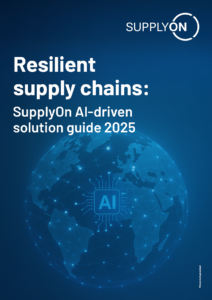Secure supply despite reduced capital lockup – how is this possible? (Part 2)
![]()
The digitalization of the supply chain paves the way for well-synchronized material flows
What can be done to create greater transparency and reduce the stock and inventory levels by better synchronizing the material flows?
Now, to put it simply, one has to figure out how to eliminate the causes of the lack of transparency and synchronicity of material flows. In this regard, the entire process of supply chain planning and management must be examined.
The planning aspect is also referred to as “Sales, Inventory & Operations Planning” (“SI&OP”). Market requirements and demand should always be the starting point of the planning cycle.
The subsequent “supply chain execution” refers to the operational implementation of the plan and the determination of critical variance to be taken into account in the next planning cycle.
On the whole, it is a complex cycle (see diagram), which takes place in many companies with only minor software support and is significantly decoupled between the individual stages. The cycle can only proceed efficiently and smoothly if the relevant data of all business partners involved is considered and processed.
Decoupling leads to inefficiencies
The greater the basic decoupling between these phases and individual process steps and the lower the systematic support, the slower, more non-transparent and error-prone the overall process.
Typical symptoms in such companies are:
- Company-wide process execution with suppliers and logistics service providers is usually based on communication via email and fax.
- Numerous media disruptions during the processes
- Suppliers do not provide feedback or feedback is not processed on time
- Proactive disaster prevention instead of planning and exception-based work
- High proportion of manual activities not creating value among a large number of employees
- Critical errors and supply problems are not identified or are not identified on time
- No uniform and coherent picture of the supply situation in the entire company
Digitalization of the supply chain ensures better synchronized material flows and lower inventories
As a key component and precondition for the successful implementation of Industry 4.0 principles, digitalization of the supply chain aims for automated, electronic process execution among all of the participating companies. If this is achieved, processes will be faster and more transparent, which ultimately unlocks the key to better synchronized material flows and lower stocks and inventories. Increased transparency of the supply situation and automatic warning messages, which ensure exception-based work, enable stock to be reduced systematically without negatively impacting security of supply.
Although the preconditions for successful projects have improved significantly in recent years, many companies are still at the start of their deliberations. Companies that have already taken initial steps toward Industry 4.0 by consistently phasing out obsolete communication technology, and whose digitalization of the supply chain is firmly established in the corporate strategy, are assured a certain edge, which may make them stand out from the competition in the long run.
Steps towards a digital supply chain
More specifically, these companies address the following issues:
- Consistent and thorough abolishment of email and fax when executing supply chain processes, for internal processes as well as for processes stretching beyond corporate boundaries.
- Introduction of process execution free of media disruptions using formats that can be directly electronically processed.
- Identification and avoidance of errors prior to transmission of business data via plausibility checks and preallocation of data fields.
- Inclusion of all relevant external partners in this change process worldwide.
- Automated identification of critical situations and transmission of warning messages via dedicated supply chain visibility and performance management solutions.
- Creation of a common approach among the internal supply chain organization and external business partners (customers, suppliers, carriers) to facilitate a more expeditious, effective and collaborative problem-solving whenever inconsistencies are identified. (This is because there is only one version of truth and separated ERP systems are unable to supply it.)
For many companies, the final destination is well out of reach; however, it should be remembered that every path begins with a small step. Where do you stand, are you already on the move?




